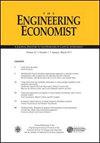Pricing real options based on linear loss functions and conditional value at risk
IF 1
4区 经济学
Q4 BUSINESS
引用次数: 1
Abstract
Abstract The main purpose of this paper is to expand real option analysis out of the realm of pure financial option pricing techniques. To overcome many of the well-known concerns by adopting the financial option pricing techniques for modeling real options problems such as replicating portfolio concept, geometric Brownian motion as underlying stochastic process, and estimating project volatility, we propose an alternative real option valuation based on the loss function approach. The option value determined by the loss function approach is equivalent to the expected value of perfect information (EVPI) in decision analysis. It basically sets the upper bound of risk premium to pay in retaining the options. In practice, many firms utilize the concept of Value at Risk to manage their portfolio risk. If a firm sets a target VAR, then we may be able to link this VAR in refining the actual risk premium to pay in hedging the risk embedded in the investment. With this practice in mind, we present a logic to figure out an appropriate amount of real option premium to pay for a given level of risk tolerance. A comprehensive example is presented to demonstrate the computational procedures as well as economic interpretations on the outcomes.基于线性损失函数和风险条件值的实物期权定价
摘要本文的主要目的是将实物期权分析从纯粹的金融期权定价技术领域扩展开来。为了克服许多众所周知的担忧,通过采用金融期权定价技术来建模实物期权问题,如复制投资组合概念,几何布朗运动作为潜在的随机过程,以及估计项目波动率,我们提出了一种基于损失函数方法的替代实物期权估值。损失函数法确定的期权值相当于决策分析中的完美信息期望值。它基本上设定了保留期权所支付的风险溢价的上限。在实践中,许多公司利用风险价值的概念来管理他们的投资组合风险。如果一家公司设定了一个目标VAR,那么我们就可以将这个VAR与实际风险溢价联系起来,以对冲投资中隐含的风险。考虑到这一实践,我们提出了一个逻辑来计算给定风险承受水平下支付的适当数额的实物期权溢价。给出了一个全面的例子来演示计算过程以及对结果的经济解释。
本文章由计算机程序翻译,如有差异,请以英文原文为准。
求助全文
约1分钟内获得全文
求助全文
来源期刊

Engineering Economist
ENGINEERING, INDUSTRIAL-OPERATIONS RESEARCH & MANAGEMENT SCIENCE
CiteScore
2.00
自引率
0.00%
发文量
14
审稿时长
>12 weeks
期刊介绍:
The Engineering Economist is a refereed journal published jointly by the Engineering Economy Division of the American Society of Engineering Education (ASEE) and the Institute of Industrial and Systems Engineers (IISE). The journal publishes articles, case studies, surveys, and book and software reviews that represent original research, current practice, and teaching involving problems of capital investment.
The journal seeks submissions in a number of areas, including, but not limited to: capital investment analysis, financial risk management, cost estimation and accounting, cost of capital, design economics, economic decision analysis, engineering economy education, research and development, and the analysis of public policy when it is relevant to the economic investment decisions made by engineers and technology managers.
 求助内容:
求助内容: 应助结果提醒方式:
应助结果提醒方式:


